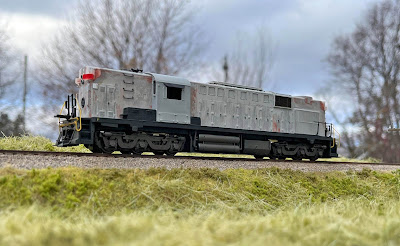RS-18 kitbashing projects - like James Bond - never really die. Rapido may have made the RS-18 classic Canadian modelling tradition dead, there is still some room for the lovely MLW RSD-17. This locomotive was MLW version of the Alco RSD-15 which wasn't that much popular but kind of acquired some fame on the Pennsylvania Railroad. While RSD-17 sales never materialized, a demonstrator unit was built in May 1957 and went on a one year trial one over several Canadian railways including Canadian Pacific as #7007, Canadian National as #3899 and PGE as #624. At the end of this demonstration, the unit went back to MLW shops were is sat idle for a while as evidence of its failure as a viable commercial product. It was no fault of the locomotive itself, but it wasn't suited to the customers need. One day, when CP was making an order at MLW, the lone RSD-17 was thrown into the deal and CP got it for a song. It would work mainly in Ontario and got famous later as the Empress of Agincourt. When one truck failed during the early 1990s and couldn't be repaired, the elegant locomotive went into preservation. It may have been a commercial failure, but it certainly got famous and memorable later in life.
 |
| RSD-17 CN 3899 in René, QC back in 1957 (credit: Larry Russell) |
My interest in this project started when I saw a color picture of RSD-17 moving a long freight train over the National Transcontinental (NTR) La Tuque Subdivision near René, QC. In my eyes, the Empress had always been an Ontarian thing and now, I had proof it performed its duty in Québec. The same happened when it ran over the CP as a few pictures can testify. Thus, the venerable locomotive became much closer to my heart and to what I'm currently modelling: the NTR.
For this reason, a few months ago, I acquired a used and slightly damaged BLI RSD-15 with the goal of converting it into CN #3899 and equipping it with a nice LokSound 5 decoder. A few days ago, I started the conversion project by trying to stripe the paint with SuperClean. It did absolutely nothing and I had to resort to something else. I did remember that BLI shells were notoriously hard to stripe and plastic could warp. I was about to do an internet search when I simply decided to dunk it into 91% isopropyl alcohol. It would be alright isn't it?
Move forward the next morning and the paint was still adhering on most parts except the cab. As always a good help from the ultrasonic cleaner would make it easier... Meanwhile I observed the cab and remarked the surface was rough and there was some creases forming on the plastic. I was a little bit worried, but not too much. After a few hours, it was time to finish cleaning the body shell and I was out for some nasty surprises. The shell was basically ruined. The surface was rough and several details like door edges were damaged. Cracks appeared here and there. It was time to do the long due internet search and discover I should have never used alcohol on a RSD-15 shell. Oh well... too late for regrets. I contacted BLI for a spare shell which they had in stock for US$95 including shipping. That's about CAD$140 plus customs which is quite costly. That said, the shell BLI sells is complete, including all the details, running boards and handrails. I think its a fair price by current standards, but I wanted to see if I could restore my shell with some care.
I tried a few techniques on various small spots and concluded the most efficient method was to burnish the surface with a dull round hobby knife blade. It closed the porous surfaces and generally helped to straighten the edge deformations. In more severe cases, glazing putty came to my rescue and I also resorted to sand the surface with 600 grit paper. Everything was then polished with 1200 grit sandpaper. At the end of the day, the shell wasn't perfect, but certainly serviceable enough to warrant some detailing.
Detailing was fast and straightforward. Adter building so many RS-18s out of RS-11s, it's now ingrained in my muscle memory. Hood notches were filled with styrene and I started to add grabirons, horns, carve a brake wheel housing and craft sand hatches. I reckon some doors weren't exactly on the same spot on RSD-17 than RSD-15, but I came to the conclusion it was good enough to leave them were they are. Also, pictures from the Empress and brass models are full of contradictions about these doors, so I'm not concerned that much about it.
Now the model is almost ready for primer. I expect this will show more surface defects to address, but it shouldn't be that hard. I'm surprised how the project went considering the horrible mistakes made at first. But here we are and the madness continue!






No comments:
Post a Comment